[Monthly column] Worldwide Koryu Dojo Report Vol.16 Toda-ha Buko-ryu and Shinto Muso-ryu in New Jersey, USA
Interview and text by Grigoris Miliaresis
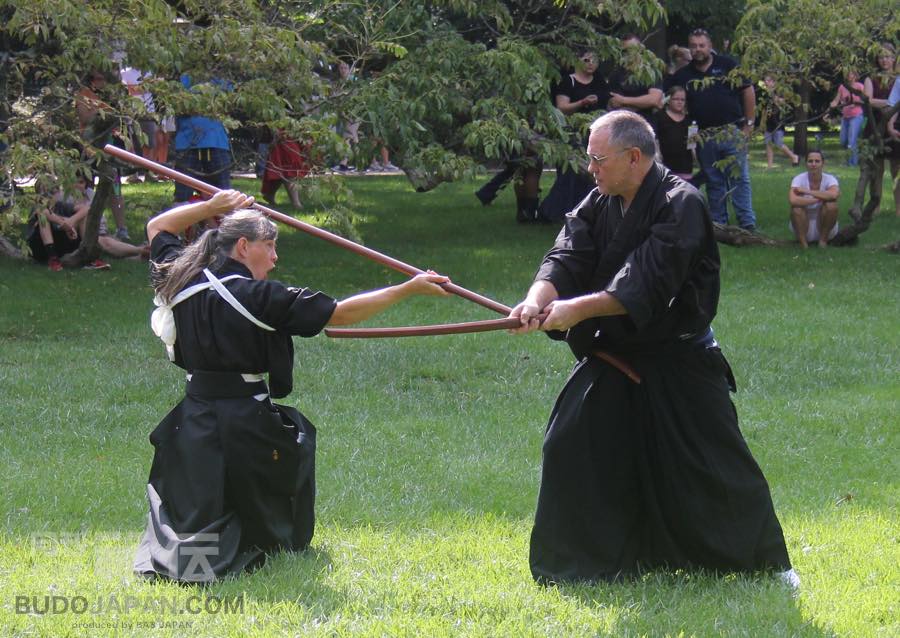
Meik and Diane Skoss, Toda-ha Buko-ryu, Japanese Festival at the Missouri Botanical Gardens, 2012 (photo by Wes Foreman)
As practitioners, instructors, researchers, writers and publishers (Koryu Books) Meik and Diane Skoss have been contributing to the dissemination of the classical Japanese martial arts for almost 50 years. This 16th part of the Worldwide Koryu Dojo Report is an introduction to their journey and work in the world of koryu.
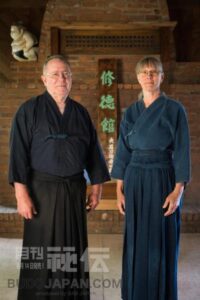
Meik and Diane Skoss in the new Shutokukan (photo by Andrew Bordwin)
Dojo ID
Name: Shutokukan
Location: Central New Jersey, U.S.A.
[Note: our former shared location in East Hanover, NJ was closed due to the COVID-19 pandemic. We are now in the process of setting up a home dojo, which should be functional by the end of May 2021. For now, we train outdoors in the field.]
Foundation year: 1999
Arts practiced: Toda-ha Buko-ryu naginatajutsu, Shinto Muso-ryu jo, Yagyu Shinkage-ryu kenjutsu, Yagyu Seigo-ryu battojutsu
Local affiliation: Shinto Muso-ryu Taiseikai, NY Yagyukai
Japan affiliation (instructor/organization): Toda-ha Buko-ryu Soke Dairi Kent Sorensen; Yagyukai
Instructor’s name: Meik Skoss (Toda-ha Buko-ryu & Yagyu Shinkage-ryu)
Diane Skoss (Shinto Muso-ryu)
Instructor’s credentials/grades:
Meik: Toda-ha Buko-ryu shoden (Muto), honden, and betsuden mokuroku, inka-jo (Nitta); Shinto Muso-ryu menkyo; Yagyu Shinkage-ryu senior member; ZNKR jodo 5th dan; jukendo 5th dan; aikido (Aikikai) 4th dan; tankendo 3rd dan; atarashii naginata 2nd dan.
Diane: Shinto Muso-ryu menkyo kaiden; Toda-ha Buko-ryu okuden; jukendo 5th dan; aikido (JAA) 4th dan; ZNKR jodo 3rd dan; tankendo 3rd dan
Number of members: about 25
Members advanced/beginners ratio: Toda-ha Buko-ryu 75/25; Shinto Muso-ryu 50/50
Days of practice/week: Sunday (naginata in the morning and jo in the afternoon); Wednesday evenings (jo); Yagyu Shinkage-ryu currently inactive.
Website/social media/email: https://shutokukan.org/ and https://Koryu.com/
1) When and how did you get involved with the classical arts you practice?
Meik: I read Donn Draeger’s books on koryu in college and was very intrigued by what I learned abou the physical and mental training they embody. Also, the strong emphasis on the ryu as a coherent group made a very strong impression on me. I began Shinto Muso-ryu in February 1974, with Shimizu Takaji (Rembukan); Toda-ha Buko-ryu (Muto Mitsu) and Tendo-ryu (Sawada Hanae) in March 1976 (Shinjuku Taiikukan); and Yagyu Shinkage-ryu (Yagyu Nobuharu) in January 1979 (Nakano Taiikukan).
Diane: I started jo in 1991 after meeting my teacher Phil Relnick at a Japan Martial Arts Society meeting in Tokyo. I joined the Toda-ha Buko-ryu in 1993 at Nitta Suzuo Sensei’s invitation after Meik and I got married.
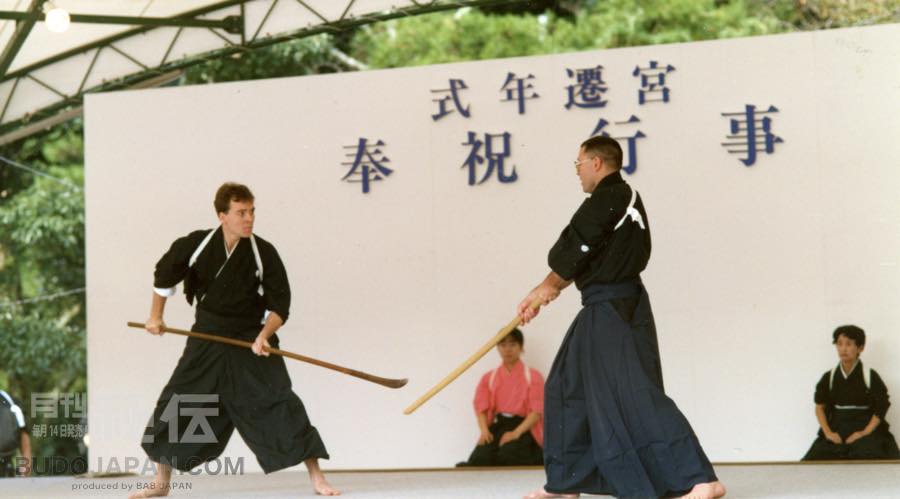
Kent Sorensen and Meik Skoss, Toda-ha Buko-ryu, Hohno Enbu, Ise Jingu, 1995
2) How widespread in your country are the classical martial arts you practice and the classical arts in general?
Meik: There are three Toda-ha Buko-ryu dojo and seven or eight groups of Yagyu Shinkage-ryu, counting both Yagyukai and other lines.
Diane: There are quite a few koryu jo groups here, maybe as many as two dozen (not counting jodo, which is not the same). Twenty-five years ago it was rather difficult to find any authentic koryu in the United States. Nowadays, finding a legitimate instructor is much easier, though most are located near large population centers, and many students must travel some distance to train with their teachers. I have students who drive for seven hours to come train one weekend per month.
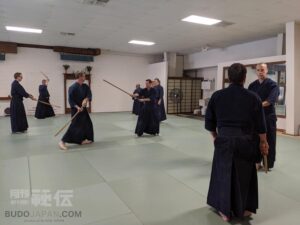
Shinto Muso-ryu Godogeiko 2019 (photo by Will Schutt)
3) Do you and the members of your group travel to Japan to practice?
Meik: Several Shinkage-ryu members go to Japan at least once a year. I have gone six or seven times since I returned to the U.S. in December 1997.
Diane: I occasionally return to visit old friends at places where I trained when I lived in Tokyo and to make a pilgrimage to Mt. Homan and the Muso Gonnosuke shrine at Kamado Jinja in Dazaifu.
4) What is the biggest difficulty in practicing classical martial arts?
Meik: Understanding the mindset and cultural context.
Diane: Commitment, focus, cultural context, mindset. Communicating what it means to be a member of a classical Japanese martial ryu is a constant and significant challenge. A teacher must continually remind students of the need to let go–of power, of ego, of individual preferences–and to allow themselves to be subsumed into the ryu. This isn’t easy for Americans! But for folks in this country the largest obstacle is simply having enough time to train.
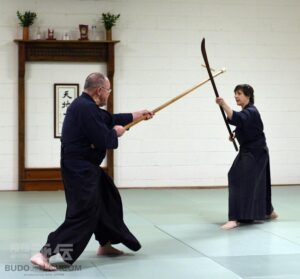
Meik Skoss with Beth Johnson, Toda-ha Buko-ryu, Shutokukan Kagami Biraki 2018 (photo by Andre Ferreira)
5) What is the difference between practicing classical and modern Japanese martial arts?
Meik: Mindset and cultural context.
Diane: Deep historical roots and the family-like nature of the ryu contrast with the formal bureaucratic organizational style of modern arts. The emphasis for us is on getting together and training, not achieving the next rank or recognition. There is no competition except with one’s own self.
6) What is your art’s strongest characteristic, historically or technically?
Meik: Toda-ha Buko-ryu is a system that develops a strong will, enabling its exponents to “crush” the enemy. Yagyu Shinkage-ryu teaches both effective technique using subtle, sophisticated timing and angles, and emphasizes observing the opponent so closely that the exponent is able to detect his opponent’s intent even as the opponent realizes it himself.
Diane: Shinto Muso-ryu is characterized by extremely sophisticated “use of force”; the response is precisely matched to the situation. Options range from simple control to lethal blows. The jo is a very flexible weapon that can be used like a sword, like a naginata, like a spear, or simply like a stick.
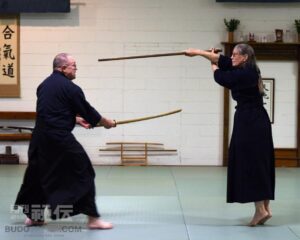
Meik and Diane Skoss, Shinto Muso-ryu, Shutokukan Kagami Biraki 2018 (photo by Andre Ferreira)
7) What is the benefit of practicing classical martial arts in the 21st century- especially for someone who isn’t Japanese?
Meik: Learning a complex set of physical skills with deep cultural and psychological aspects that resonate even today in countries outside Japan.
Diane: Community. Mindset. Learning how to pay attention to details and the value of repetition. Sharpening observational skills and learning how to “read” a situation. Today’s world needs everyone to understand that any group is only as strong as its weakest member, so that we all work to support and benefit each other. This is a fundamental Japanese concept that is of enormous benefit to everyone everywhere; this contrasts with traditional American “individualism,” and American students gain immensely in learning to integrate it into their lives.
8) Is there a Japanese community in your city? Do you have any connections to them and to other aspects of Japanese culture?
Meik & Diane: There is a significant Japanese community in New York City, but not where we live in New Jersey. There is a local high school that offers Japanese language instruction.
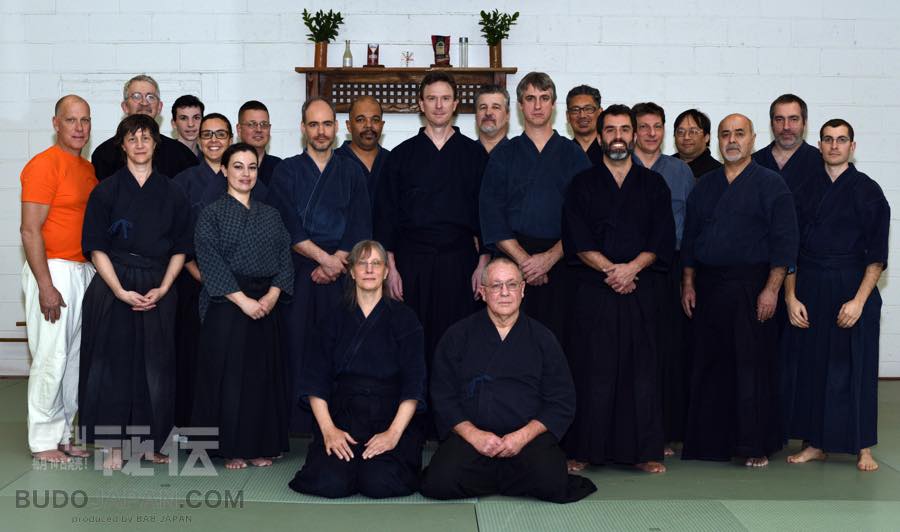
Shutokukan Kagami Biraki 2018 (photo by Andre Ferreira)

















